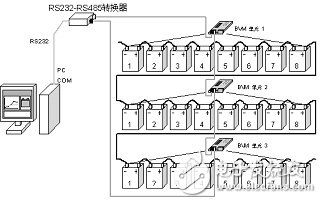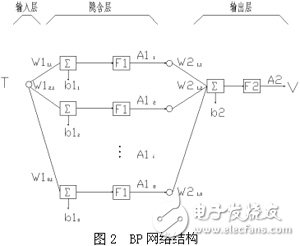The float voltage has a direct impact on the capacity and life of the battery. Higher than the recommended limit float voltage will reduce battery life and capacity. Below the recommended float voltage will result in insufficient battery capacity. A reduction in battery capacity will result in a reduction in UPS backup time, which is one of the most important performance indicators for UPS. Therefore, it is necessary to adjust the charging voltage of the battery according to the actually measured temperature. The following is an example of the relationship between cell float voltage (v) and battery life at 25oC. It can be seen that in order to ensure the life of the battery, the float voltage should be guaranteed to be between 2.25v and 2.30v at an ambient temperature of 25oC, and the battery float voltage deviation can only be 50mV. Under different ambient temperatures, the battery float voltage is different, and there is a one-to-one nonlinear relationship between the battery. The battery manufacturer can give some specific data. For the data that the battery manufacturer failed to give, BP artificial neural network can be applied. Fit an unknown value that meets the accuracy requirements. In today's mainstream UPS power series products, the battery voltage monitoring unit includes a voltage monitoring module, a temperature measuring module, and monitoring software. It is an important accessory for UPS power supplies and is installed in the battery cabinet (Figure 1). BVM can use the inspection method to monitor the battery voltage. Each group of batteries uses a BVM unit. The measurement data is uploaded via the RS485 bus and sent to the PC serial port via the RS485/RS232 converter, effectively implementing the online monitoring battery pack. The balance of performance of each single battery provides a detection basis for ensuring good power supply performance of each battery, and can accurately detect backward batteries in the battery pack. Figure 1 intelligent battery monitoring system The BVM consists of 51 MCUs and A/D converters. The measured voltage and temperature values ​​are sent to the MCU through the A/D converter. The table is stored in the EEPROM of the single chip microcomputer. The record in the table is a non-linear relationship between the battery float voltage and the ambient temperature. By comparing the way of looking up the table, the voltage value in the table is compared with the actual measured battery float voltage at a certain temperature value, and if it exceeds the set range, an alarm is issued. A BP artificial neural network with bias and at least one S-type hidden layer plus a linear output layer can approximate any rational function. Since the relationship between the temperature and the float voltage does not change, a smooth temperature-floating charge curve can be obtained by the operation of the BP artificial neural network. All unknown data can be predicted with high precision when the manufacturer only provides a small amount of data and an unknown function expression. Therefore, all the values ​​on the temperature and float voltage relationship curves can be accurately obtained by the operation of the BP artificial neural network. 4.1 Network structure: The BP network is a typical multi-layer network, which is divided into an input layer, an implicit layer, an output layer, and a fully interconnected layer between layers. There is no interconnection between the same layer of neurons (see Figure 2). Since the input and output are each a set of data, one neuron in the input layer is used, and one neuron is output in the layer; the input matrix is ​​T, and the output target vector is V. The key is how to select the number of neurons in the hidden layer. The number of neurons in the hidden layer should not be too small, otherwise the network cannot learn well, the number of trainings required is too high, and the training accuracy is not high. In general, the number of neurons in the hidden layer of the network is more versatile, but not too much. Usually, if the problem can be solved, one or two neurons are added to speed up the error. There are two empirical formulas: Where S1 is the number of neurons in the hidden layer; r is the number of neurons in the input layer; s is the number of neurons in the output layer; S1=4*1+1*1= 5 neurons or After repeated trials, 8 neurons were used, S1=8. 4.2 Activation function: The activation function of neurons in a BP network is non-linear and must be a bounded function of continuous differentiable and monotonically rising. The input/output relationship is also non-linear and its value can vary continuously. The hidden layer uses a hyperbolic tangent S-type activation function, and the output layer uses a linear activation function. The number of neurons in the hidden layer is set to i (i=8), where the output of the i-th neuron is 4.3 BP network training: BP network, the input is a certain temperature value, the output is the reference value of the measured voltage value, and it is compared with the actual measured battery float voltage, and if it exceeds the allowable range, it will alarm. T represents temperature and V represents a reference value of the measured voltage value. The actual working temperature is 0oC to 41oC. The data from 0 to 41 during training causes network training difficulties, so change it to -20 to 20, as long as 20 is the actual temperature value. Divide the data provided by the battery manufacturer into two collections. The training set (Figure 3) is: Input matrix T = -20: 2 : 20; Output matrix V V==[14.4, 14.38, 14.32, 14.24, 14.18, 14.12, 14.04, 13.98, 13.92, 13.86, 13.78, 13.72, 13.66, 13.58, 13.52, 13.46, 13.38, 13.32, 13.26, 13.2, 13.2]; 14.4, 14.38 , 14.32, 14.24, 14.18, 14.12, 14.04, 13.98, 13.92, 13.86, 13.78, 13.72, 13.66, 13.58, 13.52, 13.46, 13.38, 13.32, 13.26, 13.2, 13.2]; Write the training program in Matlab language, the network training process: First set the parameters as follows: Max_epoch = 30000; Err_goal = 0.002; Program running result: TRAINBP: 30000/30000 epochs, SSE = 0.00260954. W1 = [-0.1094 -0.1207 -1.0054 -0.9631 1.5095 0.4468 1.7631 0.9540] T B1 = [-1.2748 1.2489 0.4120 0.1571 -0.6891 0.9935 -1.5833 0.0657] T W2 = [0.3228 0.2993 -0.0883 0.2113 1.0839 -0.0217 -0.7304 -0.2670] B2 =13.8159 UnsuCCessfully. Network training was unsuccessful. Train again with the obtained W1, B1, W2, B2... until Err_goal =0.0015 successfully get: W1 = [-0.1094 -0.1207 -1.0054 -0.9631 1.5095 0.4468 1.7631 0.9540] T B1 = [1.2748 1.2489 0.4120 0.1571 -0.6891 0.9935 -1.5833 0.0657] T W2 = [0.3228 0.2993 -0.0883 0.2113 1.0839 -0.0217 -0.7304 -0.2670] B2 =13.8159 4.4 Testing BP Network Modify the program with the resulting matrix, then enter the test set data to find the error The test set (Figure 4) is: T= -19:2:21 V = [ 14.4, 14.34, 14.28, 14.22, 14.14, 14.08, 14.02, 13.96, 13.88, 13.82, 13.76, 13.68, 13.62, 13.56, 13.48, 13.42, 13.36, 13.3, 13.22, 13.2, 13.2]; The result of the operation (Figure 5): TRAINBP: 0/10000 epochs, SSE = 0.0942136. TRAINBP: 100/10000 epochs, SSE = 0.00825354. TRAINBP: 145/10000 epochs, SSE = 0.0049739. The test set has SSE = 0.0942136 and the squared error sum is 10mV, which satisfies the requirements. Since the battery voltage monitoring module uses the BP network fitting data, it has a scientific basis for accurately determining the battery float voltage.
Mini Circuit breakers, also named as the air switch which have a short for arc extinguishing device. It is a switch role, and also is a automatic protection of low-voltage electrical distribution. Its role is equivalent to the combination of switch. Fuse. Thermal Relay and other electrical components. It mainly used for short circuit and overload protection. Generally, According to the poles, mini Circuit breaker can be divided into 1P , 1P+N , 2P, 3P and 4P.
Miniature Circuit Breaker,Electronics Miniature Circuits Breaker,Automatic Miniature Circuit Breaker,Mini Circuit Breaker,MCB Wenzhou Korlen Electric Appliances Co., Ltd. , https://www.zjthermalrelay.com


![]()
![]()




Design and Application of BP Network in Battery Voltage Monitoring Module
1 The necessity of battery voltage monitoring